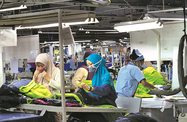The government of Myanmar has taken steps to encourage the development of a manufacturing base, including the establishment of industrial zones (IZs) and, more recently, special economic zones (SEZs). Advantages such as an inexpensive labour force and proximity to major markets like India and China have international firms jostling for more information about the implementation of the zones.
First implemented in the 1990s, Myanmar’s IZs are designated areas for manufacturing. According to the Ministry of Industry, there are 18 IZs across the country, with the largest – located in East Yangon – the base for more than 1000 enterprises. Authorities have said that these IZs create jobs for locals and, in late 2012, the government announced that it was setting up seven new zones across the country.
However, investors who choose to establish operation in the IZs face challenges, including power shortages, poor roads and complex import/export procedures, according to a 2011 study by Myinmo Zaw and Toshihiro Kudo. The researchers also noted that these zones lack the standard incentives that governments often put in place for industrial development centres, such as tax breaks or one-stop shop services.
An SEZ law, passed in 2011, addressed some of these criticisms, including provisions such as tax holidays for five years, followed by 50% income tax relief on overseas sales, and exemption on Customs duty for certain goods (e.g., machines) for five years. However, the Foreign Investment Law, passed in 2012, has a similar package of benefits that applies to any business in Myanmar and has made the comparative legal advantages of an SEZ somewhat redundant.
Three SEZs have been planned along the coast of Myanmar, named and known after their locations: Dawei, Kyaukpyu and Thilawa.
Thai construction giant Italian-Thai Development and the Myanmar Port Authority signed an $8.6bn-deal in November 2010 to develop Dawei into a deep-sea port and 250-sq-km industrial estate with sea, land and rail links to neighbouring countries. However, there have been delays, and recent reports suggest a significant downsizing of the plan to create a light-industry estate rather than a heavy-industry zone focused around the port.
Meanwhile, the Kyaukpyu SEZ will be home to the beginning of a large oil-and-gas pipeline that stretches up to Kunming in the Yunnan province in southern China. Although this would be an important strategic plan for Myanmar’s northern neighbour, the town and surrounding area of Rakhine State has been the focus of renewed Muslim-Buddhist conflict, heightening the risk for investors.
The Thilawa SEZ, on the other hand, has gained much more traction since the passing of the SEZ Law in 2011. A memorandum of understanding was signed for the development of this SEZ on May 25, 2013, laying out cooperation among nine Myanmar public companies and a Japanese consortium of Mitsubishi, Marubeni and Sumitomo, with Japanese Prime Minister Shinzo Abe present at the signing ceremony. According to China’s Global Times, U Set Aung, the chairman of the Thilawa SEZ Management Company and deputy minister of National Planning and Economic Development, declared that the Thilawa SEZ represented a milestone in the relationship between Japan and Myanmar, creating job opportunities and up-to-date technologies for citizens.
The Thilawa SEZ’s location, close to Yangon, and committed funding by Japanese low-interest loans, make it a more likely success story for the coming years. Mitsubishi, Marubeni and Sumitomo are all conducting feasibility studies to use the zone, alongside Japan International Cooperation Agency and the Japanese government.
Still, Myanmar faces challenges to realising its industrialisation plans, including most notably infrastructure that is desperately in need of expansion and an upgrade. As Lim Yew Hoe, the managing director of Myanmar Brewery, told OBG, “Capacity is a huge issue, especially at the ports, which has limited growth. This bottleneck needs to be addressed.”
Consistent power supply is also an issue. Blackouts are common in most areas of Yangon, and even the biggest and most centrally located companies still rely on generators to keep operations running. The Asian Development Bank estimates energy demand will double within the next five years, from 12,459m KWh in 2012 to 25,683m KWh by 2018.
Authorities have started to address these problems. In December 2012 the government approved the Framework for Economic and Social Reforms, which gives priority to the development of roads and railways. This will go some way towards alleviating investor concerns about entering the Myanmar market.

